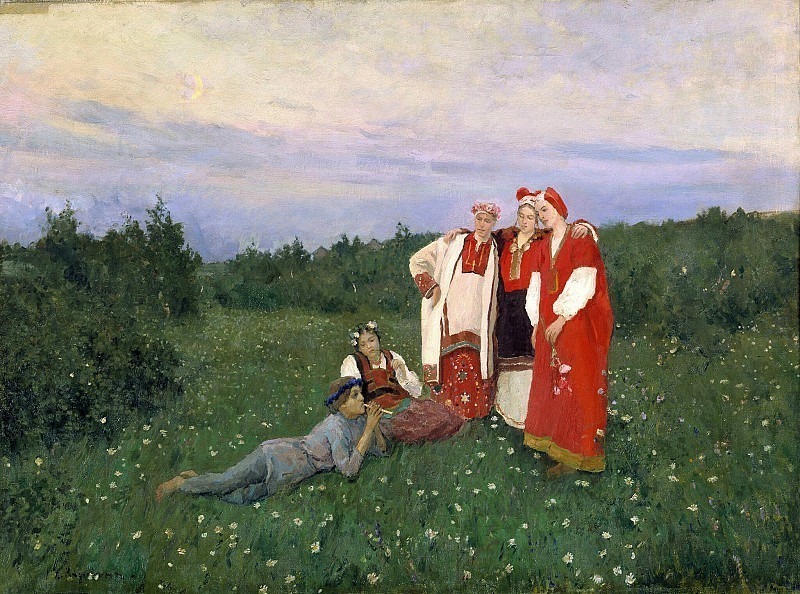Northern idyll Konstantin Alekseevich Korovin (1861-1939)
Konstantin Alekseevich Korovin – Northern idyll
Edit attribution
Download full size: 2048×1519 px (0,5 Mb)
Painter: Konstantin Alekseevich Korovin
Location: The State Tretyakov Gallery, Moscow (Государственная Третьяковская галерея).
After participating in Savva Mamontov’s northern expedition, Russian artist Konstantin Korovin conceived the idea of creating a series of paintings about life in the North. In 1886 the artist painted The Nordic Idyll, captivated by the natural beauty of the harsh northern region and the purity of the soul of its inhabitants. The canvas depicts the pre-dawn time: a new moon has already appeared on the slightly darkened sky.
Description of Konstantin Korovin’s painting "The Northern Idyll".
After participating in Savva Mamontov’s northern expedition, Russian artist Konstantin Korovin conceived the idea of creating a series of paintings about life in the North. In 1886 the artist painted The Nordic Idyll, captivated by the natural beauty of the harsh northern region and the purity of the soul of its inhabitants.
The canvas depicts the pre-dawn time: a new moon has already appeared on the slightly darkened sky. Everything around is green, the grass carpet is carpeted with wonder baubles, and the gentle melody of a village shepherd’s pipe is playing as he lays on the grass. Three peasant girls in brightly colored sundresses are enjoying the coolness of the evening time and swaying slightly in time with the sounding tune. The artist gave their faces both stern and lyrical at the same time. And also he perfectly conveyed all the splendor of folk patterns and attire details with his brush.
His broad brushwork manner allows us to see clearly delineated figures of the girls on the background of the cloudy sky and low northern trees.
The main emphasis was placed on the color red. However, it must be said that on this canvas Korovin harmoniously combines the contrast of three colors: white, green and red, which are so loved by Russian people. It appears that the painter has given the picture a folkloric direction, emphasizing the inseparable connection between national beauty and nature.
True, the images of the girls seem a little kooky. Korovin himself felt that the figures somehow do not connect with the landscape, so he decided to reunite them with the beauty of white daisies on green grass. In this way the amazing beauty of the northern landscape brightened up the impression of inconsistency, because in "Idyllia" we have an opportunity to observe the saturation of colors even in the pre-dawn period.
By creating such impressive scenery with his broad and sweeping strokes, Korovin has given us a truly majestic masterpiece.
Кому понравилось
Пожалуйста, подождите
На эту операцию может потребоваться несколько секунд.
Информация появится в новом окне,
если открытие новых окон не запрещено в настройках вашего браузера.
You need to login
Для работы с коллекциями – пожалуйста, войдите в аккаунт (open in new window).




















You cannot comment Why?
In the painting Northern Idyll, we see a serene natural landscape under a soft, overcast sky, possibly at dusk or dawn. The scene is dominated by a field of lush green grass dotted with small white wildflowers, stretching towards a treeline in the middle ground. A hint of a village or scattered dwellings can be faintly discerned along the horizon.
The foreground and mid-ground are occupied by four figures, all appearing to be young and of Slavic or Northern European heritage, dressed in traditional folk attire.
On the left, a young person in a muted blue tunic and trousers lies on their back in the grass, playing a pipe. This figure is adorned with a flower wreath on their head. To their right, a young woman, also wearing a flower wreath, is seated, with her head resting on her arm. She is dressed in a red embroidered vest over a white blouse and a dark skirt.
Standing in the center and to the right are three more figures, appearing to be young women. They are grouped together, with their arms around each others shoulders, conveying a sense of close camaraderie and affection. The woman on the far left of this standing group wears a white outer robe with elaborate red embroidery at the hem and cuffs, and a red and white headdress. The middle figure is in a red, embroidered tunic over a dark garment and a red headdress. The woman on the far right is clad in a vibrant red dress with white sleeves and a red headdress, and she holds a small bouquet of pink flowers.
The overall mood of the painting is one of peacefulness, youth, and connection with nature, embodying an idyll. The title itself suggests an idealized, harmonious rural or pastoral scene, often associated with innocence and simple pleasures.
The subtexts of the painting can be interpreted in several ways: